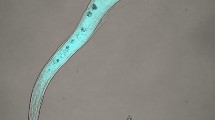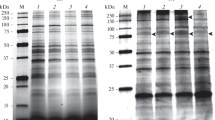Abstract
Metacercariae ofFasciola hepatica were excysted in a simple system based on the stimuli determined by Dixon (1966). Reproducibly high levels of excystment (70–80%) were obtained within 3h. Equal volumes of human serum and medium RPMI 1640 with 2% washed human red blood cells supported better growth in vitro than human serum diluted with ELac or NCTC 135. Reduced rates of growth were observed with serum concentrations lower than 50%. During culture over a period of 14 weeks some organisms in every culture grew to a length of 3 mm at a linear rate approximately one quarter of the growth rate in vivo (mouse). A few parasites suddenly began to develop more rapidly after six weeks in culture and reached 6–7 mm in length, comparable to the size of sexually matureFasciola grown in mice. These cultured worms showed extensive development of the uterus, vitellaria, and testes with spermatozoa. The ovary remained rudimentary and egg formation did not occur.
Similar content being viewed by others
References
Davies C, Smyth JD (1978) In vitro cultivation ofFasciola hepatica metacercariae and of partially developed flukes recovered from mice. Int J Parasitol 8:125–131
Dawes B (1962) On the growth and maturation ofFasciola hepatica L. in the mouse. J. Helminthol 36:11–38
Dawes B, Hughes DL (1970) Fascioliasis: the invasive stages ofFasciola hepatica in mammalian hosts. Adv Parasitol 8:259–274
Dixon KE (1966) The physiology of excystment of the metacercaria ofFasciola hepatica L. Parasitology 56:431–456
Kratz WA, Myers J (1955) Nutrition and growth of several blue-green algae. Am J Bot 42:282–287
Osuna-Carillo de A AO, Guevara-Pozo D (1974) Cultivo de helmintos parasitos I. Primeiros resultados con un medio basico para el cultivo in vitro deFasciola hepatica L. Rev Iber Parasitol 34:137–140
Sewell MMH, Purvis GM (1969)Fasciola hepatica: the stimulation of excystation. Parasitology 59: 4P
Smith MA, Clegg JA, Webbe G (1976) Culture ofSchistosoma haematobium in vivo and in vitro. Ann Trop Med Parasitol 70:101–108
Smyth JD (1956) Studies on tapeworm physiology VIII. Occurrence of somatic mitosis inDiphyllobothrium spp and its use as a criterion for assessing growth in vitro. Exp Parasitol 5:260–270
Taylor EL, Mozley A (1948) A culture method forLymnaea truncatula. Nature 161:894
Wikerhauser T, Cvetnic S (1967) Survival of young and sexually mature adultFasciola hepatica in various cell-free media with and without mammalian cell cultures. Exp Parasitol 20:200–204
Wikerhauser T, Cvetnic S, Brundnjak Z (1968) Further study on the survival of youngFasciola hepatica in cell cultures. Wiad Parazytol 14:703–705
Author information
Authors and Affiliations
Rights and permissions
About this article
Cite this article
Smith, M.A., Clegg, J.A. Improved culture ofFasciola hepatica in vitro. Z. Parasitenkd. 66, 9–15 (1981). https://doi.org/10.1007/BF00941940
Received:
Issue Date:
DOI: https://doi.org/10.1007/BF00941940




